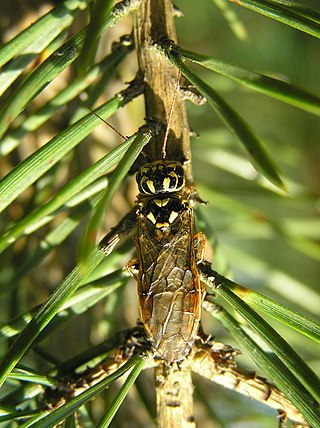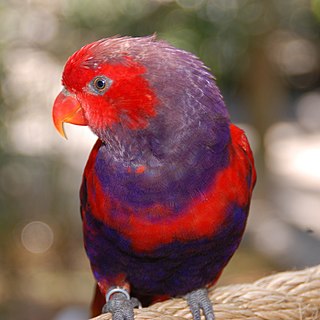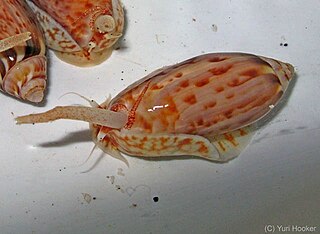
Uropygi is an arachnid order comprising invertebrates commonly known as whip scorpions or vinegaroons. They are often called uropygids. The name "whip scorpion" refers to their resemblance to true scorpions and possession of a whiplike tail, and "vinegaroon" refers to their ability when attacked to discharge an offensive, vinegar-smelling liquid, which contains acetic acid. The order may also be called Thelyphonida. Both names, Uropygi and Thelyphonida, may be used either in a narrow sense for the order of whip scorpions, or in a broad sense which includes the order Schizomida.

The Decapoda or decapods are an order of crustaceans within the class Malacostraca, and includes crabs, lobsters, crayfish, shrimp, and prawns. Most decapods are scavengers. The order is estimated to contain nearly 15,000 extant species in around 2,700 genera, with around 3,300 fossil species. Nearly half of these species are crabs, with the shrimp and Anomura including hermit crabs, porcelain crabs, squat lobsters making up the bulk of the remainder. The earliest fossils of the group date to the Devonian.

The longhorn beetles (Cerambycidae), also known as long-horned or longicorns, are a large family of beetles, with over 35,000 species described. Most species are characterized by extremely long antennae, which are often as long as or longer than the beetle's body. In various members of the family, however, the antennae are quite short and such species can be difficult to distinguish from related beetle families such as the Chrysomelidae. The scientific name of this beetle family goes back to a figure from Greek mythology: after an argument with nymphs, the shepherd Cerambus was transformed into a large beetle with horns.

The Tenebrionoidea are a very large and diverse superfamily of beetles. It generally corresponds to the Heteromera of earlier authors.

The Pamphilioidea are a small superfamily within the Symphyta, containing some 250 living species restricted to the temperate regions of Eurasia and North America. These hymenopterans share the distinctive feature of a very large, almost prognathous head, which is widest ventrally.

The Megalodontesidae are a small family of sawflies, containing a single living genus, Megalodontes, with some 40 species restricted to the temperate regions of Eurasia. Larvae of Megalodontesidae feed on herbaceous plants. They are distinguished from the closely related Pamphiliidae by their serrate or pectinate antennae.

Pamphiliidae is a small wasp family within Symphyta, containing some 200 species from the temperate regions of North America and Eurasia. The larvae feed on plants, using silk to build webs or tents, or to roll leaves into tubes in which they feed, thus earning them the common names leaf-rolling sawflies or web-spinning sawflies. Some species are gregarious and the larvae live in large groups. Fossils of Pamphiliidae have been dated to the Jurassic period.

The sargassum fish, anglerfish, or frog fish is a frogfish of the family Antennariidae, the only species in its genus. It lives among Sargassum seaweed which floats in subtropical oceans. The scientific name comes from the Latin histrio meaning a stage player or actor and refers to the fish's feeding behaviour.

The red-and-blue lory is a small, strikingly-colored parrot endemic to Indonesia. The species inhabits a single island, Karakelong, in the Indonesian archipelago, although it was formerly found on the Sangihe Islands and other parts of the Talaud Islands.

Eos is a genus of parrots belonging to the lories and lorikeets tribe of the family Psittaculidae. There are six species which are all endemic to islands of eastern Indonesia, most within very restricted ranges. They have predominantly red plumage with blue, purple or black markings. Males and females are similar in appearance.

Acantholyda is a genus of sawflies.

Olivoidea is a taxonomic superfamily of minute to medium-large predatory sea snails, marine gastropod mollusks in the order Neogastropoda.

Polygonus is a genus of Nearctic and Neotropical spread-winged skippers in the family Hesperiidae.

Pamphilius is a genus of leaf-rolling sawflies within the Symphyta belonging to the family Pamphiliidae.

Iris histrio, the Syrian iris, is a species in the genus Iris, it is classified in the subgenus Hermodactyloides and section Reticulatae. It is a bulbous perennial from Central Asia: Kyrgyzstan, Israel, Lebanon, Syria and southern Turkey.
Rhysodromus is a genus of spiders in the family Philodromidae. It was first described in 1965 by Schick. As of 2022, it contains 28 species.
Rhysodromus histrio is a species of spiders in the family Philodromidae. It is the type species of its genus. It is found in North America, Europe, Turkey, Caucasus, Russia (Siberia), Central Asia and China.

Rhipiceridae is a family of beetles found worldwide. The larva of rhipicerids are parasitoids of cicada nymphs. Rhipiceridae and Dascillidae form the super family Dascilloidea, within the Elateriformia.
Pamphilius gyllenhali is a species of insect belonging to the family Pamphiliidae.

Caenolyda is a genus of insect belonging to the family Pamphiliidae first described by Konow in 1897. The species of this genus are found in Europe.















